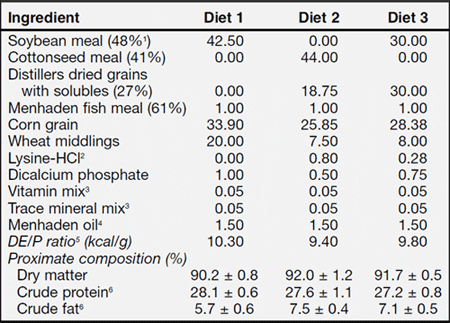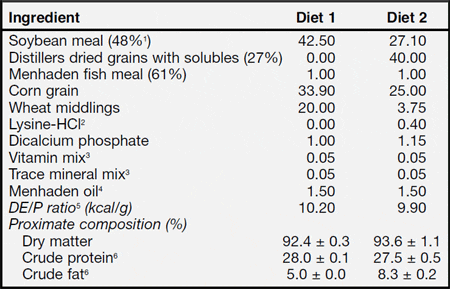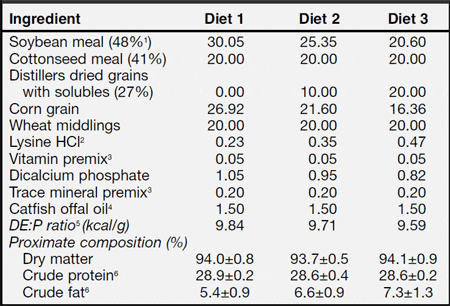One product that shows promise is distillers dried grains with solubles (DDGS), which is a by-product of producing ethanol from corn. It contains about 27% protein and is readily available because of rapid growth of the ethanol industry. Historically, DDGS has been used sparingly in catfish diets, in part because it has been highly variable in nutritional value and in part because it has not been priced competitively. Though quality and price are improving, there are still some issues that may limit DDGS use in catfish diets. One issue is that DDGS typically contains about one-fourth of the lysine found in SBM. But, if necessary, supplemental lysine can be used to compensate for this shortfall. Early studies showed that up to 30–35% DDGS could be used in catfish diets without supplemental lysine (Lovell 1980; Webster et al. 1991, 1992, 1993; Zhou et al. 2010). Other researchers reported using 30–40% DDGS in catfish diets with lysine supplementation (Lim et al. 2009).
Another more problematic issue with using DDGS in catfish diets is that the product contains relatively high levels (20–40 ppm) of xanthophylls (mainly lutein and zeaxanthin). Yellow pigmentation was reported in catfish fed diets high in xanthophylls in the late 1980s (Lee 1987). Little attention was given to this report since there was not a yellow pigmentation problem in commercial catfish culture at that time. However, within the past few years, yellow pigmentation has become a problem in the industry, in part because of the increasing levels of corn-based by-products used in catfish diets to reduce cost. Also, pigmentation may occur at times when fish are underfed because they may consume xanthophyll-rich natural foods. A recent study showed that when catfish are fed diets containing about 8 ppm or more xanthophylls, a yellow coloration is imparted to edible flesh, making the fish unacceptable to the consumer (Li et al. 2009). This was not a consideration in earlier studies with DDGS, nor was it in the experiments 1 and 2 reported herein. Extracting DDGS with ethanol reduces the concentrations of these pigments and allows higher levels of DDGS to be used in catfish diets (Li et al. 2011). However, the added cost of the extraction may further limit its value as feedstuff for use in commercial catfish feeds. This report presents results from three experiments in which DDGS was evaluated as replacements for SBM in catfish diets.
Methods
All Experiments
Experimental diets containing 28% protein were manufactured as extruded floating pellets at the Delta Western Research Center (DWRC) in Indianola, Mississippi. Fresh lots of each feed were manufactured as needed. All dietary ingredients were obtained from the DWRC and were from commercial sources. All diets were formulated to meet or exceed the dietary requirements for channel catfish (NRC 1993; Robinson et al. 2001).
Fingerling channel catfish averaging about 106 to 205 pounds per 1,000 (size varied among studies) were stocked into 0.1-acre ponds at a density of 6,000 fish per acre at DWRC or the National Warmwater Aquaculture Center (NWAC) in Stoneville, Mississippi, depending on the study. Five ponds were allotted to each dietary treatment in a complete randomized design. Fish were fed once daily to apparent satiation from mid-April to mid-October for one or two growing seasons depending on the specific study. During the growing season, water temperature and dissolved oxygen were measured in early morning, midafternoon, and throughout the night. Routine aeration was provided when dissolved oxygen levels decreased to 4 ppm. Total ammonia-nitrogen (TAN), nitrite-nitrogen (NO2 -N), and pH were measured weekly during the growing season. Water quality was maintained in ranges considered adequate for optimum fish performance (Tucker and Robinson 1990). Dead fish were removed from ponds, weighed, and recorded for correction of feed conversion ratio (FCR) at the end of the study. Fish that were fed for two growing seasons were overwintered in their respective ponds and fed the appropriate experimental diets once or twice weekly when water temperatures exceeded 55°F.
At the end of each study, 30 fish from each pond were selected for processing to determine dressed yield. Fillets (one fillet per fish, 10 fish per pond) were stored at -4°F for subsequent proximate analyses. After sampling, all fish from each pond were harvested, counted, and weighed. Data collected included weight gain, feed conversion ratio, survival, dressed yield, and fillet proximate composition (AOAC 2000). All data were subjected to ANOVA and the Fisher’s protected LSD procedure (Steel et al. 1997) using Statistical Analysis System version 8.0 software (SAS Institute, Inc., Cary, North Carolina, USA).
Specific Experiments
Experiment 1 — Three diets were evaluated in which SBM was replaced with DDGS or a combination of DDGS, cottonseed meal (CSM), and supplemental lysine (Table 1). Fingerling channel catfish averaging 106 pounds per 1,000 were grown in ponds at the DWRC facility for 330 days over two growing seasons.
Experiment 2 — Two diets were evaluated in which SBM was replaced in part with DDGS plus supplemental lysine (Table 2) in ponds at the DWRC facility. Fingerling channel catfish averaging 143 pounds per 1,000 were fed for 120 days in one growing season.
Experiment 3 — Three diets containing 0%, 10%, or 20% DDGS as a replacement for part of the SBM were evaluated in ponds at the NWAC (Table 3). Higher levels of DDGS were not used to maintain the concentration of xanthophylls in the diet at no more than 7 ppm. Fingerling channel catfish averaging 205 pounds per 1,000 were fed for 165 days in one growing season.
Table 1. Ingredient and Proximate Composition of Experimental Diets (Percentage, As-Fed) Used in Experiment 1.

2Contained 78% lysine.
3Same as described by Robinson et al. (2001).
4Sprayed on the finished pellets.
5DE/P ratio = digestible energy to crude protein ratio. The DE was estimated based on tabular values of NRC (1993) and Robinson et al. (2001).
690% dry matter basis.
Table 2. Ingredient and Proximate Composition of Experimental Diets (Percentage, As-Fed) Used in Experiment 2.

2Contained 78% lysine.
3Same as described by Robinson et al. (2001).
4Sprayed on the finished pellets.
5DE/P ratio = digestible energy to crude protein ratio. The DE was estimated based on tabular values of NRC (1993) and Robinson et al. (2001).
690% dry matter basis.
Table 3. Ingredient and Proximate Composition of Experimental Diets (Percentage, As-Fed) Used in Experiment 3.

2Contained 78% lysine.
3Same as described by Robinson et al. (2001).
4Sprayed on the finished pellets.
5DE/P ratio = digestible energy to crude protein ratio. The DE was estimated based on tabular values of NRC (1993) and Robinson et al. (2001).
690% dry matter basis.
Result
Experiment 1 — There were no significant differences in feed consumption or survival among fish fed the various experimental diets (Table 4). Fish fed the diet containing 30% DDGS (without CSM) gained more weight and converted the feed more efficiently than fish fed control diet (without DDGS and CSM). Weight gain and feed conversion ratio (FCR) of fish fed the diet containing 18.75% DDGS and 44% CSM were intermediate, not significantly different from either the control diet or the diet containing 30% DDGS. There were no differences in percentage visceral fat, carcass yield, fillet yield, and nugget yield among fish regardless of diet (Table 5). Fish fed the diet containing 30% DDGS had a higher percentage of fillet fat and lower moisture compared with fish fed the other diets.
Experiment 2 — There were no significant differences in weight gain and survival of fish fed the control and the diet containing 40% DDGS (Table 6). Feed consumption and FCR were significantly lower for the fish fed the DDGS diet than the control. There were no differences in fillet proximate composition nor were there differences in percentage of visceral fat, carcass, fillet, or nugget yield (Table 7).
Experiment 3 — There were no significant differences in any production characteristic measured (Table 8). However, carcass yield and fillet yield decreased as the amount of DDGS increased in the diet (Table 9). There were no significant differences in fillet composition among dietary treatments.
Table 4. Mean Production Characteristics of Channel Catfish Fed Experimental Diets Containing Various Levels of Distillers Dried Grains With Solubles (DDGS) in Experiment 1.1

2Mean initial weight was 106 pounds per 1,000 fish.
Table 5. Mean Processing Characteristics and Fillet Composition of Channel Catfish Fed Experimental Diets Containing Various Levels of Distillers Dried Grains With Solubles (DDGS) in Experiment 1.1

2Means represent average values of five ponds per treatment with 30 fish per pond.
3Carcass yield is a percentage of the carcass (without head and viscera) weight relative to whole fish weight.
Table 6. Mean Production Characteristics of Channel Catfish Fed Experimental Diets Containing 0% and 40% Distillers Dried Grains With Solubles (DDGS) in Experiment 2.1

2Mean initial weight was 143 pounds per 1,000 fish.
Table 7. Mean Processing Characteristics and Fillet Composition of Channel Catfish Fed Experimental Diets Containing 0% and 40% Distillers Dried Grains With Solubles (DDGS) in Experiment 2.1

2Means represent average values of five ponds per treatment with 30 fish per pond.
3Carcass yield is a percentage of the carcass (without head and viscera) weight relative to whole fish weight.
Table 8. Mean Production Characteristics of Channel Catfish Fed Experimental Diets Containing 0%, 10%, and 20% Distillers Dried Grains With Solubles (DDGS) in Experiment 3.1

2Mean initial weight was 205 pounds per 1,000 fish.
Table 9. Mean Processing Characteristics and Fillet Composition of Channel Catfish Fed Experimental Diets Containing 0%, 10%, and 20% Distillers Dried Grains With Solubles (DDGS) in Experiment 3.1

2Mean represent five ponds per diet and 30 fish per pond.
3Carcass yield is a percentage of the carcass (without head and viscera) weight relative to whole fish weight.
Discussion
Initially we recommended a 20% inclusion rate for DDGS in catfish diets. This was based on a study with DDGS conducted a number of years ago (summarized in Robinson and Li 2005) in which 22.5% DDGS was used to replace part of the SBM and fed to channel catfish in experimental ponds. The present experiments demonstrate that up to 30–40% DDGS with supplemental lysine can be used to partially replace SBM in channel catfish diets without adversely affecting weight gain or FCR. This is in general agreement with previous studies on DDGS in catfish diets, with the exception that in some studies supplemental lysine was not needed. Catfish diets that contained up to 30–40% DDGS and also included animal protein and/or a relatively high level of SBM did not appear to require lysine supplementation (Lovell 1980; Webster et al. 1991, 1992, 1993; Lim et al. 2009; Zhou et al. 2010). However, catfish diets containing 30–40% DDGS without animal protein and/or low levels of SBM required supplemental lysine in this study. However, there was an exception to this observation since supplemental lysine appeared to be necessary in catfish diets containing fishmeal when DDGS was used to replace SBM (Lim et al. 2009)
The FCR of fish fed diets containing 30–40% DDGS was significantly lower in both Experiments 1 and 2, compared with those fed a SBM control diet. This result agrees well with data from other studies with channel catfish fingerlings (Li et al. 2010, 2011). However, the FCR was not improved when DDGS was used in conjunction with CSM in Experiment 1. Also, this improvement in FCR was not seen in Experiment 3 and has not been reported in other studies (Webster et al. 1991, 1992, 1993; Robinson and Li 2005; Zhou et al. 2010). We do not know the cause of this response, but since it occurred in both experiments in this study, as well as in laboratory studies, it bears some inspection. Li et al. (2010, 2011) speculated that the improvement in FCR of fish fed diets containing DDGS products could be due to the presence of yeast cells in the DDGS.
All diets were formulated to meet or exceed the nutrient and energy requirements for channel catfish (NRC 1993; Robinson et al. 2001). It appears that we may have underestimated the digestible energy value for DDGS; in Experiment 1, there was a significant increase in fillet fat for fish fed the diet containing 30% DDGS compared with those fed the SBM control diet. The difference was not significant in Experiments 2 or 3, but both visceral and fillet fat tended to be higher in fish fed the DDGS diet compared with fish fed the SBM control diet in Experiment 2. In Experiment 3, fillet fat was slightly higher in fish fed the diet containing 20% DDGS. Increased fattiness in catfish fed diets containing DDGS has previously been reported (Lim et al. 2009). DDGS typically contain about 9% crude fat, which is considerably higher than other commonly used feed ingredients in channel catfish diets. Crude fat concentrations in diets containing DDGS were higher than control diets. It is anticipated that high dietary fat levels result in an increase in body fat. However, the higher fat and possibly higher digestible energy levels in diets containing DDGS would not likely account for the improved FCR of fish fed this diet because all the experimental diets contained an excess of digestible energy.
Carcass and fillet yields were significantly lower in fish fed diets containing DDGS in Experiment 3. In Experiments 1 and 2, though not statistically significant at P = 0.05, carcass and fillet yields tended to decrease in fish fed diets containing DDGS. This response may be related to the increase in visceral and fillet fat found in fish fed DDGS diets in Experiments 1 and 2. Visceral fat was not measured in Experiment 3, but fillet fat was slightly higher in fish fed the diets containing DDGS.
The diets containing DDGS had a higher level of fat than the control diets, and this generally results in an increase in body fat. Though the decrease in carcass and fillet yield is rather small and seemly insignificant, it could result in significant losses when taken over the entire catfish industry.
Conclusions
It appears that DDGS is well utilized by catfish at levels up to 30–40% when the diet is supplemented with lysine. Lysine supplementation may not be necessary if the diet contains a moderate to high level of SBM and/or animal protein. However, if a decrease in dressed yield in fish fed diets containing DDGS is reported by catfish processors, then that may limit the use of DDGS in catfish diets. Also, the presence of yellow pigments in the diet may further limit the amount of DDGS that can be used. When catfish are fed diets containing xanthophylls at levels as low as 8–10 ppm, an undesirable yellow pigmentation of edible tissue may occur (Li et al. 2009). Even though these pigments are not harmful and may actually be beneficial as nutrients to the consumer, they are unacceptable primarily because of esthetics (Robinson and Li 2009). Whereas corn grain and corn gluten feed — two corn-based products commonly used in commercial catfish diets — contain about 13 ppm xanthophylls, DDGS contains relatively higher xanthophylls varying from 20–40 ppm. Since a typical commercial catfish diet contains 15–25% corn grain to ensure good pellet quality and that the pellets float on the water surface, the amount of DDGS that can be used is likely limited to 10–20% of the diet. Extraction of these pigments using ethanol is an option that would increase the inclusion rate of DDGS in catfish diets, but the additional expense associated with this may make the product too expensive.
May 2013




